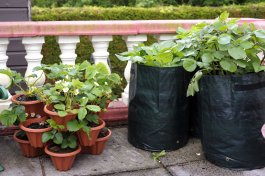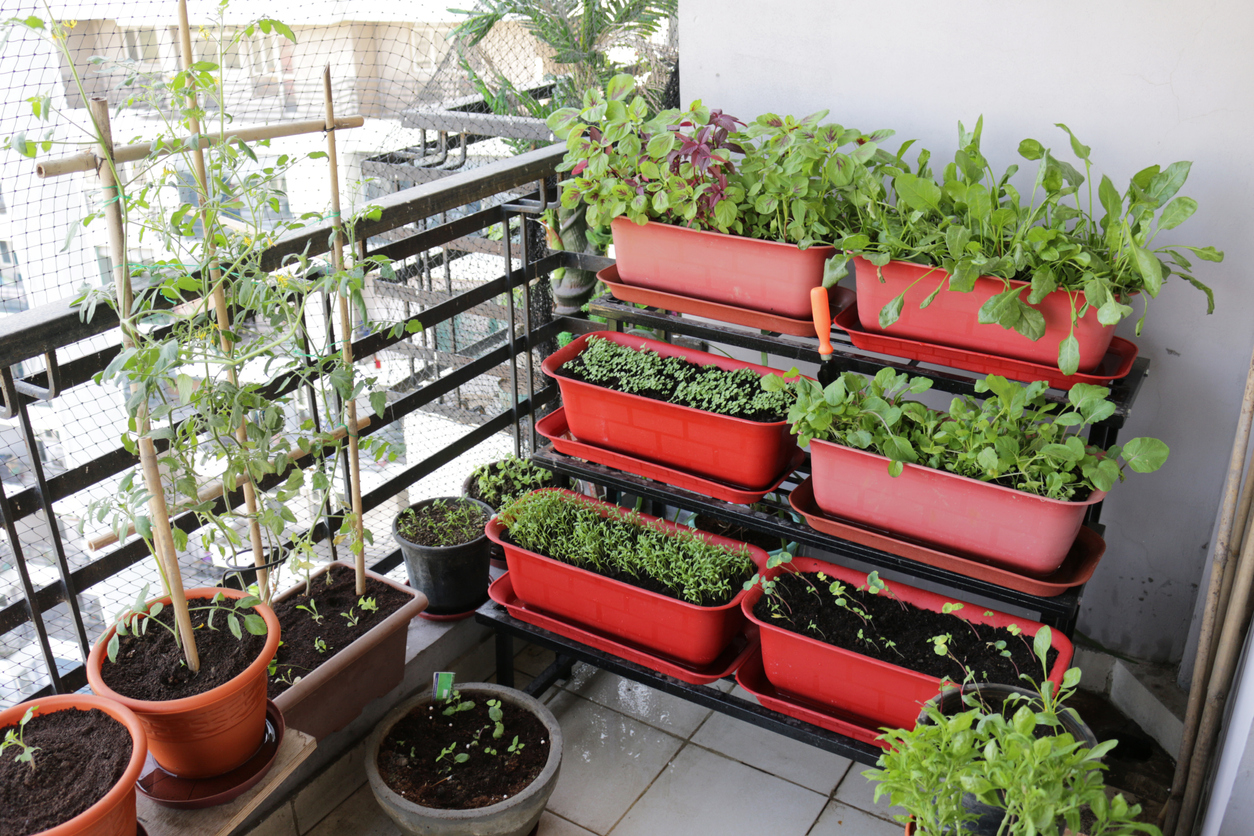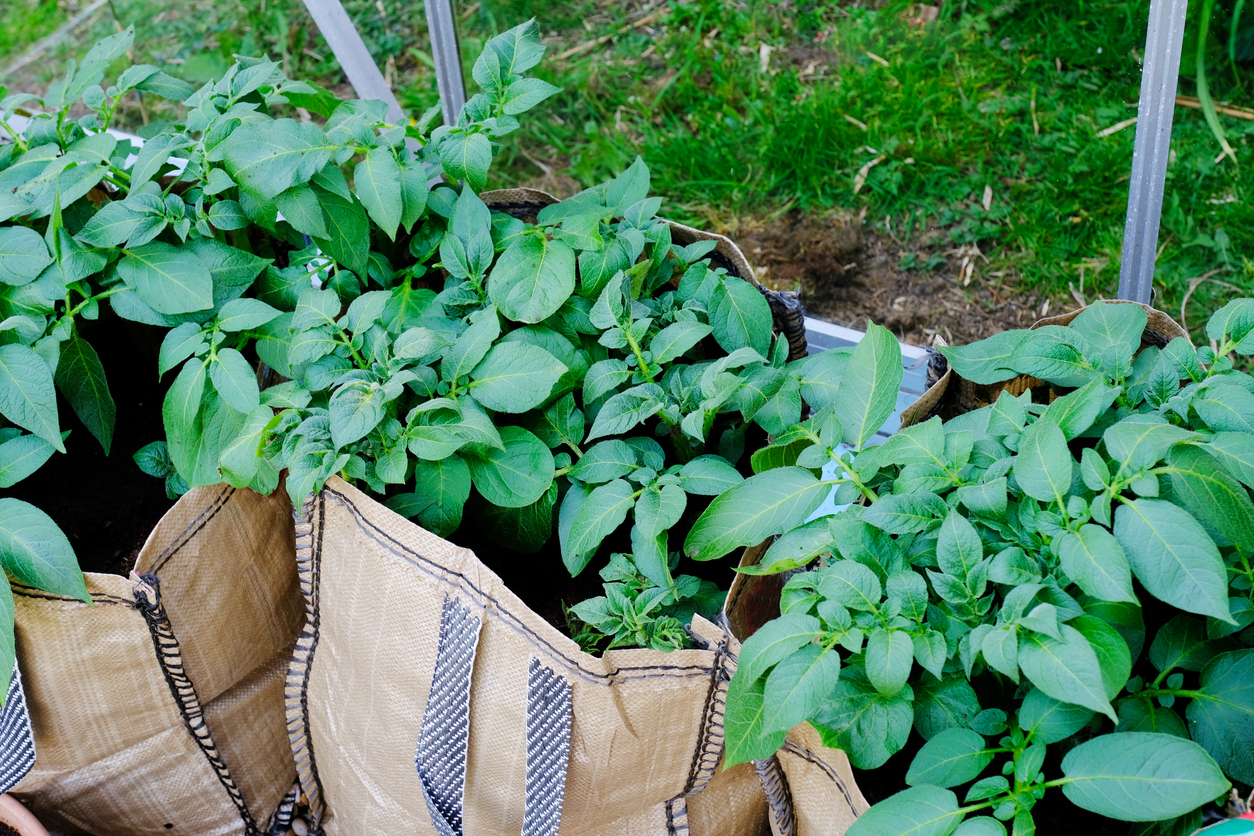
Not everyone has the space for a Freedom Garden in the backyard. An edible front porch garden or balcony garden is a lot more attainable. In fact, even if you do have space for a big garden, there are some distinct advantages to growing your herbs and veggies right outside your door.
For one, you don’t have to worry as much about deer, rabbits, and skunks eating your ripe tomatoes. You can snip some fresh rosemary without getting drenched in a rainstorm. Then there’s the fact that a front porch garden gives your home a lovely, fresh look.
What to grow, though? That’s always the question. Some vegetables grow better in containers than others. I love asparagus. There’s nothing like those first tender spears of the season grilled with a little olive oil, salt, and pepper. But asparagus isn’t really a container vegetable. The good news about asparagus though, is that if you do have a patch of backyard space, asparagus is the ultimate Freedom Garden food because it will keep coming back every spring for 30+ years. If you add new crowns every year or few years, you’ll be harvesting them indefinitely.
But if all you have for your garden is a front porch, the good news is that you still have a very wide selection of vegetables and herbs to choose from, many of which can thrive in containers. There’s even a hybrid variety of corn (Burpee’s On Deck Hybrid) that’s bred specifically for container gardens.
One thing that gets skipped a lot when we talk about a front porch garden or balcony garden is that space is limited. For taller or bushier plants, you’ll need larger containers, so bear that in mind when you consider which vegetables to grow. One approach for maximizing space is to plant more vegetables in a bigger pot rather than using multiple smaller pots. If you don’t plan to move your front porch garden around, that can work. Just remember that these larger containers can get really heavy.
It’s also worth mentioning that, especially with limited space, you should stick to vegetables you like or you know your friends, family, and neighbors like. No matter how well cucumbers can grow in a container, if you don’t enjoy them either as cucumbers or as pickles, there’s no point in growing them.

Growing in Standard Containers
- 1. Herbs. I’m listing herbs as one category here, even though there are plenty to choose from. Almost all of them grow well in containers, they’re usually easy to grow, and they enhance darn near any other vegetable you cook with. Personally, I like sage, basil, oregano, rosemary, thyme, and chives. Those are the herbs I use most often when I cook, so it makes sense for me to grow them. I use a fair amount of mint, too, but there is a section of it that grows next to my house, and it seems to do just fine on its own. Seriously, I don’t even water it, and I still have plenty to make mint tea and use it in recipes.
- 2. Tomatoes. Cherry tomatoes are a winner for container gardening, but you don’t have to limit yourself here. Determinate, or bush-type, tomatoes grow to about three or four feet tall and will produce wonderfully delicious fruits. These will require larger pots and probably some staking, but if you’ve ever enjoyed a Blak Krim or Chocolate Stripes tomato, you know it’s worth the work. (Pro Tip! Plant basil in the same pot to help deter garden pests.)
- 3. Lettuce. Leaf lettuce grows quickly and does very well in containers. You may never need to buy lettuce at the grocery store again.
- 4. Peas. Peas grow quickly, and they’re so darn good straight from the pod. If you could grow candy in a garden, it would be peas. Not to mention, pea greens are seriously tasty. The only catch here is that you have to keep an eye on the soil. Peas need a fair amount of moisture, and pots can dry out quickly. On the other hand, you don’t want to overwater, either.
- 5. Radishes. Some varieties of radishes are ready to harvest within three weeks of planting, but even slower-growing varieties like the heirloom Salad Rose only take about five weeks from seed to harvest. They also grow well in cool weather.
- 6. Beets. As long as you have a pot that’s 10-12 inches deep, you can grow beets. I enjoy beets quite a bit, but I LOVE beet greens. They’re slightly sweet and mild and versatile enough that you can substitute them for most other greens in a recipe.
- 7. Eggplant. We usually think of eggplants as rather large vegetables, but for a front porch garden, there are a few varieties that are bred to grow and produce well in containers. The Patio Baby will give you up to 50 tiny “baby” eggplants per plant. Or there’s the Fairy Tale eggplant, with four-inch variegated purple and white fruits.
Of course, there are a lot more vegetables you can plant in your front porch garden. Peppers, honeynut squash, zucchini, Swiss chard, kale, cucumbers, beans, arugula, carrots, and even Brussels sprouts can all grow well in containers. Most vegetables can be grown on your front porch.
Fabric grow bags can also expand your ability to grow certain plants, like potatoes. They can be small, one-gallon containers, and you can get large, 200-gallon containers.

Growing in Fabric Grow Bags
Look up any gardening guide, and you’ll see that almost all plants need “well-drained soil.” That’s especially true in container gardening, where there’s limited space for too much water to go. One of the big advantages that many fabric grow bags offer is excellent drainage. This drainage also leads to healthier root systems.
Without getting too sciency, the porousness of fabric grow bags leads to dryer soil near the edges of the container, where there is more contact with the air. When the plant’s roots reach that drier soil and the air, they stop growing, so you don’t end up with root bound plants. That’s the claim to fame for these bags, but what other advantages do they offer?
- The breathable fabric allows heat to escape, keeping the soil cool on hot summer days.
- Fabric grow bags are easy to store. Simply clean them and fold them up when you aren’t using them and they can fit into compact storage spaces.
- They’re versatile. Built-in handles make them easy to move.
- They don’t require construction. Larger fabric grow bags can easily be used as a raised bed without the need for the tools to build one.
- Transplanting is simple and easy. Because fabric grow bags are so easy to move, you can start your seeds indoors. Then when the time comes to transplant them, you can just pick up the entire bag and “plant” it outdoors.
One of the big advantages to using fabric grow bags is that they drain quickly and easily. That also happens to be one of the big disadvantages. Because there is so much exposure to the air, the soil can dry out much faster than it does in a terra cotta, wood, or stone container. This means your plants will use more water, which means you’ll need to water them more often. Here are more of the disadvantages.
- They aren’t always eco-friendly. Surprisingly, a large number of fabric grow bags are not biodegradable. They’re made with polypropylene, which is a petroleum-based thermoplastic.
- They won’t protect your plants when it’s cold. Just like the porousness of the material allows water to evaporate, it also allows heat to escape. This means you really need to pay attention to the weather if your plants are outdoors in early spring or late fall.
- They don’t last as long as other containers. While a stone container could last for decades you may only get four or five growing seasons from all but the best fabric grow bags.
- Large grow bags aren’t easy to move. Try picking up and moving a 50-gallon container full of soil. You’ll see what I mean.
- Fabric grow bags are not very stylish. Yes, I know beauty is in the eye of the beholder, but most of the bags are pretty drab. You certainly won’t get the variety of shapes and colors you get with ceramic planters.
Are fabric grow bags right for you in your garden? They definitely offer some advantages over container gardening. Ultimately, however, it depends on how you want to work with your vegetables. An attentive gardener could have great results with or without using these containers.


 Previous
Previous

